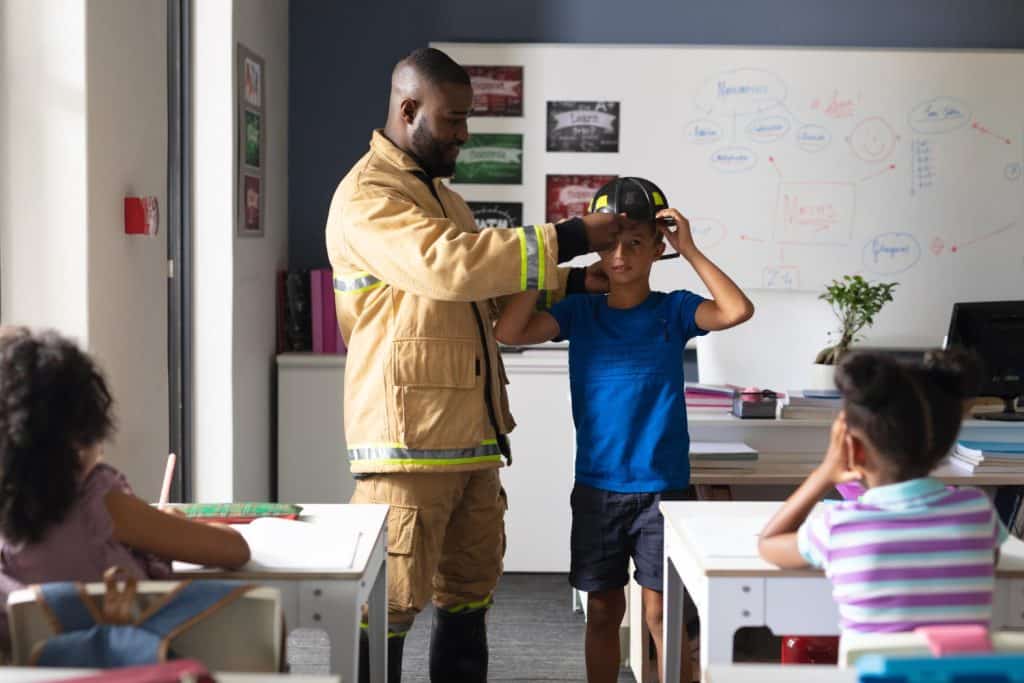School safety and federal policy responses: what you need to know

School safety and federal policy responses focus on enhancing student protection through community involvement, mental health resources, and technology, making schools safer and more supportive environments.
School safety and federal policy responses have become pivotal topics in recent years. You’ve likely seen the headlines and heard discussions circulating among parents and educators. So, what are the key developments shaping this landscape?
The role of federal policies in enhancing school safety
Federal policies play a crucial role in enhancing school safety. They provide guidelines and funding that help schools implement safety measures effectively. Understanding these policies allows educators and parents to grasp how much support is available for protecting students.
Key Federal Policies Impacting School Safety
Several key federal policies have been established to improve safety in schools. These policies not only set standards but also allocate resources to ensure schools can maintain a secure environment.
- The Every Student Succeeds Act (ESSA): This act emphasizes the importance of safe and healthy school environments.
- Gun-Free Schools Act: This policy enforces strict measures against firearms in educational settings.
- Sandy Hook Elementary School Report: This report influenced policies by highlighting essential safety measures following tragic incidents.
Additionally, federal funding programs like the Secure Our Schools Grant Program have emerged, providing schools with financial support for implementing effective safety plans. Through this program, schools have been able to enhance their security infrastructure, including better access control and surveillance systems.
Collaborative Efforts to Strengthen Policies
Collaboration between federal agencies and local law enforcement is essential to crafting policies that address school safety comprehensively. These partnerships can lead to tailored initiatives that meet specific needs in various communities. By fostering communication, stakeholders can ensure that policies are adaptable and effective.
Most importantly, community involvement in creating safety policies is vital. When parents, educators, and students participate in discussions about safety measures, policies reflect the actual needs of the school environment. This engagement ensures that policies remain relevant and practical, ultimately enhancing the impact of federal safety initiatives. Such collaboration builds a foundation of trust among all stakeholders, solidifying a committed approach toward achieving a safer school experience.
Key incidents that shaped federal responses
Many key incidents have shaped federal responses to school safety over the years. These events not only highlight the importance of safety measures but also influence policies at the national level. Understanding these incidents helps us to see how past events can drive future improvements.
Significant Tragedies
One of the most impactful events was the Columbine High School shooting in 1999. This tragic incident revealed major gaps in school safety and prompted a nationwide evaluation of protocols and emergency plans. In the aftermath, schools across the country adopted stricter security measures, and federal funding for safety initiatives increased.
- Virginia Tech shooting: This incident in 2007 led to a focus on mental health resources.
- Sandy Hook Elementary School tragedy: In 2012, the loss of young lives sparked a nationwide conversation about gun control and school safety policies.
- Parkland shooting: In 2018, students became activists advocating for policy changes, influencing lawmakers to reconsider existing laws.
These tragedies serve as critical reminders of the need for continuous improvement in safety strategies. Federal responses have evolved significantly, addressing not only school security but also mental health and community support systems.
Legislative Changes Following Incidents
In response to these incidents, several legislative measures were enacted. For example, the Gun-Free Schools Act established strict guidelines to ensure schools remain safe from firearms. This legislation has shaped the legal framework around school safety significantly. Similarly, the Every Student Succeeds Act (ESSA) emphasizes the necessity of safe and supportive learning environments, highlighting how safety is fundamental to student success.
Furthermore, community engagement in school safety discussions has become more prominent since these incidents. When schools, parents, and local authorities collaborate, they foster a safer atmosphere for students. Collective efforts ensure that policies are tailored to specific needs, making schools better equipped to handle potential threats.
Impact of mental health initiatives on school safety
Mental health initiatives have a profound impact on school safety. By addressing the emotional and psychological needs of students, schools can create a more supportive environment. This proactive approach not only helps students feel safe but also reduces the likelihood of crises.
The Importance of Mental Health in Schools
Recognizing the importance of mental health is crucial. When students are mentally healthy, they are more likely to engage positively in their school community. Programs aimed at promoting mental health can lead to improved behavior and better academic performance.
- Mental health awareness programs educate students and staff about identifying signs of distress.
- Access to counseling services ensures students receive the help they need promptly.
- Peer support groups foster a sense of belonging and reduce feelings of isolation.
Furthermore, mental health initiatives can help mitigate bullying and violence in schools. When students feel heard and supported, they are less likely to act out in harmful ways. Studies show that schools implementing such programs have lower incidents of conflict and improved overall well-being.
Collaboration with Mental Health Professionals
Collaboration between schools and mental health professionals is key to ensuring these initiatives are effective. By bringing in experts, schools can develop tailored programs that address specific issues faced by their students. Furthermore, training teachers to recognize mental health issues can lead to early intervention, dramatically affecting a student’s life.
Engaging families in mental health initiatives is also essential. Schools that involve parents in discussions about mental health create a stronger support network for students. An informed and engaged community can lead to a more robust safety net, helping to identify and address potential issues before they escalate.
Community involvement in shaping safety policies
Community involvement plays a vital role in shaping safety policies for schools. When parents, students, and local leaders work together, they can create safer environments. Engaging the community ensures that policies reflect the actual needs and concerns of those who are directly affected.
Benefits of Strong Community Engagement
Effective community engagement brings numerous benefits. First, it fosters trust between schools and families, creating open lines of communication. Second, it allows for diverse perspectives that can improve policy development. This collaborative approach can make safety measures more comprehensive and effective.
- Empowerment: When community members take part in discussions, they feel empowered and invested in the outcomes.
- Shared Responsibility: Community involvement creates a sense of shared responsibility for safety.
- Immediate Feedback: Stakeholders can provide real-time feedback on policies, making them more adaptable.
Moreover, schools that actively seek input from their communities can identify specific safety concerns unique to their areas. For instance, communities in urban environments might face different challenges compared to rural areas. Understanding these differences helps tailor policies that are relevant and effective.
Strategies for Engaging the Community
There are several effective strategies for fostering community involvement in safety policy development. Hosting workshops and safety forums allows community members to voice their opinions. Surveys and feedback forms can also gather insights on how parents and students perceive safety measures.
Furthermore, schools can establish safety committees that include parents, teachers, and local law enforcement. These committees can meet regularly to discuss ongoing safety issues and recommend changes. This collaborative effort not only creates more effective policies but also builds stronger community relationships overall.

Future trends in federal policy for school safety
Future trends in federal policy for school safety are poised to evolve in response to changing needs and emerging challenges. As schools face new threats, policymakers are increasingly focused on creating adaptable strategies that prioritize student well-being.
Incorporation of Technology
One significant trend is the incorporation of technology into safety measures. This includes using advanced security systems like surveillance cameras and access control systems. Additionally, technology can facilitate communication during emergencies through apps that allow instant updates to parents and local authorities.
- Real-time alerts can provide critical information quickly.
- Data analysis helps identify potential risks based on past incidents.
- Cybersecurity measures are also vital to protect students’ personal information.
Using technology not only enhances physical security but also fosters a safer learning environment, as students feel protected and supported.
Emphasis on Mental Health Resources
Another trend involves placing a greater emphasis on mental health resources. Federal policies are increasingly recognizing that mental health support is essential for overall school safety. Funding for mental health programs in schools is likely to increase, as understanding mental health issues can help prevent crises.
These resources can range from counseling services to training programs for teachers to identify at-risk students. By prioritizing mental health, schools can create a more compassionate environment that addresses the root causes of violence and anxiety.
Community Partnerships and Engagement
Future policies will likely foster stronger community partnerships. Engaging families, local businesses, and law enforcement creates a unified approach to safety. Schools that collaborate with community members can tailor safety strategies to their specific environments and challenges.
Moreover, fostering open communication can inform policymakers about community concerns, helping to create more effective policies. As schools become community hubs, this involvement enhances the support network for students and families, ultimately leading to a safer educational experience.
FAQ – Frequently Asked Questions about School Safety and Federal Policies
How do federal policies improve school safety?
Federal policies provide guidelines and funding for schools to implement necessary safety measures and resources, enhancing overall security.
What role does mental health play in school safety?
Mental health initiatives help address students’ emotional needs, leading to a safer and more supportive school environment.
Why is community involvement important for school safety policies?
Community involvement ensures that safety policies reflect the actual needs and concerns of students, parents, and local leaders, creating a more effective approach.
What technological advancements are affecting school safety?
Technological advancements, such as real-time alert systems and data analysis tools, are being used to enhance communication and security in schools.
What trends can we expect in future federal policies for school safety?
Future trends include a stronger focus on mental health resources, community partnerships, and the integration of technology into safety protocols.





